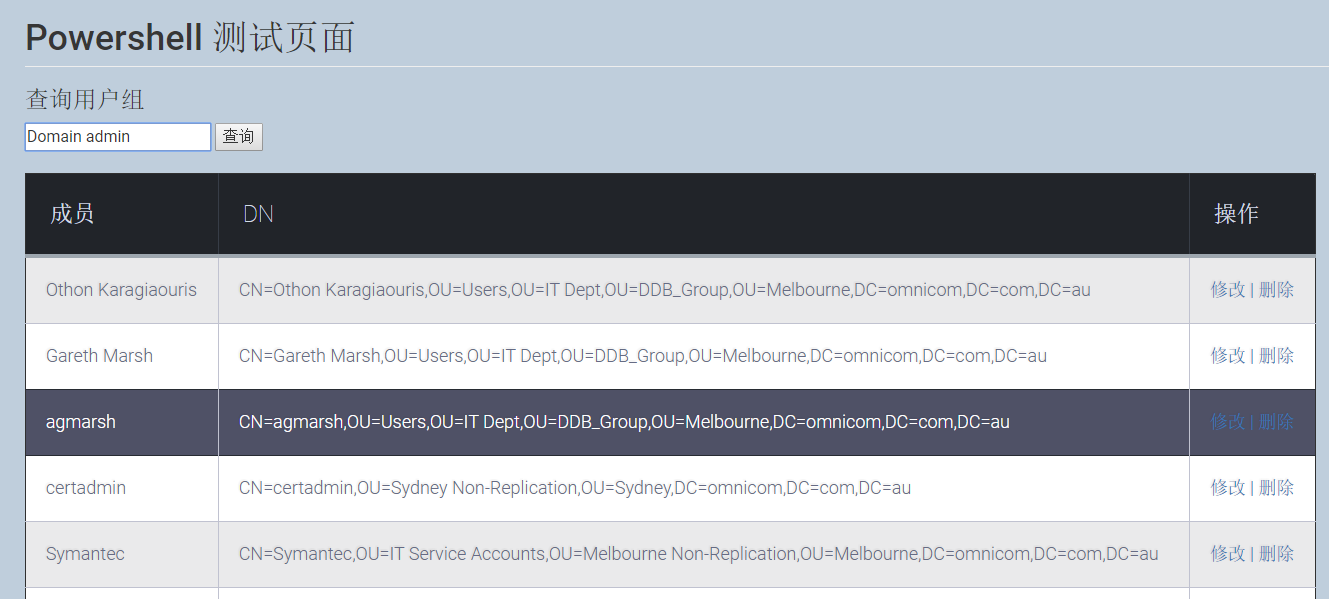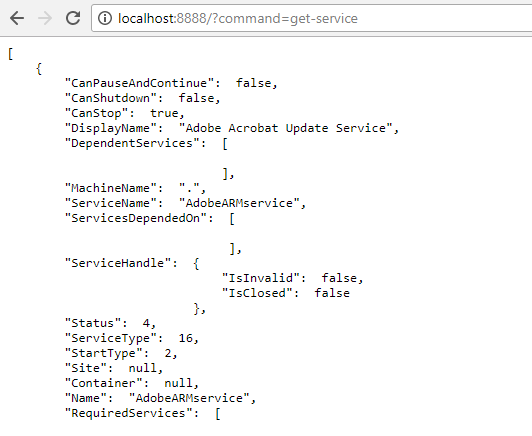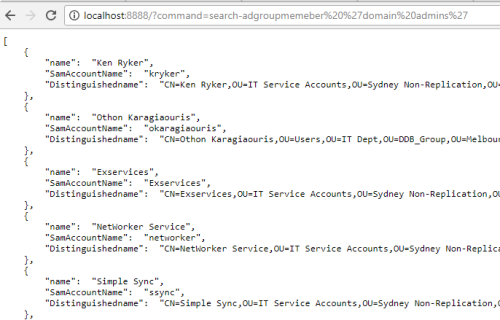Django+ PowerShell 管理AD系統
QQ群裏的Evan童鞋分享了一個很有意思的博客 http://note.youdao.com/noteshare?id=a60709c00fe88cd09155a2ef50815281 大概是如何利用Flask 調用 Powershell API 實現的一個運維管理系統。
豆子依葫蘆畫瓢,用Django成功地實現了有一個簡單的界面。 直接用Bootstrap模板弄個前端頁面,Django 框架,然後後臺調用PowerShell API實現查詢。
下面是一個簡單的demo,輸入AD的組,顯示組成員

Django沒啥好說的,基本的MTV框架流程,主要比較好玩的是這個PowerShell API的模塊。網上有現成的HttpListener的模塊可以下載,QQ群裏的童鞋做了些修改,去掉了一個驗證的功能,如果有需求,可以自己手動添加一個函數進去。我這裏圖省事是直接用的去驗證的版本。
這個模塊下載導入之後就可以執行了,他提供了一個類似restful的接口來執行Powershell的命令,直接Http get請求對應的接口,然後返回json格式的結果
Import-Module C:\users\yuan.li\Documents\GitHub\Powershell\HTTPListener.psm1 start-httplistener -verb -Auth None
測試一下:
瀏覽器

Python

值得一提的是,具體的Powershell命令放在哪裏,我們可以在兩個地方設置。一個是直接在uri裏面 command=後面輸入,簡單的命令無所謂,但是如果命令很復雜很長的話,這裏就不是太合適了;
另外一個方式是可以在HTTPListener的模塊文件裏面直接寫個function,這樣加載的時候一起放入內存了。command=後面直接跟函數名和參數就行了。
比如說:
function search-adgroupmemeber($group){
Get-ADGroupMember $group | select name, SamAccountName,Distinguishedname
}那我直接調用
http://localhost:8888/?command=search-adgroupmemeber ‘domain admins‘
顯示結果

okay,基本能工作了,那麽在django上弄個界面看看吧
url.py 路由
url(r‘^powershell‘, views.powershell),
views.py 視圖函數
import requests
def powershell(req):
if req.method=="GET":
return render(req,‘powershell.html‘)
elif req.method=="POST":
name=req.POST.get("caption")
print(name)
res=requests.get("http://localhost:8888/?command=get-adgroupmember ‘%s‘ | select name, distinguishedname"%name)
print(res)
result=res.json()
print(result)
return render(req,‘powershell.html‘,{‘result‘:result})powershell.html 模板,這裏我沒用AJAX,就是直接form進行提交
{% extends ‘base.html‘ %}
{% block css %}
<style>
.go{
width:20px;
border: solid 1px;
color: #66512c;
display: inline-block;
padding: 5px;
}
.pagination .page{
border: solid 1px;
color: #66512c;
display: inline-block;
padding: 5px;
background-color: #d6dade;
margin: 5px;
}
.pagination .page.active{
background-color: black;
color: white;
}
.hide{
display: none;
}
.shade{
position: fixed;
top: 0;
right: 0;
left: 0;
bottom: 0;
background: black;
opacity: 0.6;
z-index: 100;
}
.add-modal,.edit-modal{
position: fixed;
height: 300px;
width: 400px;
top:100px;
left: 50%;
z-index: 101;
border: 1px solid red;
background: white;
margin-left: -200px;
}
.group{
margin-left: 20px;
margin-bottom: 15px;
}
</style>
{% endblock %}
{% block content %}
<h1 class="page-header">Powershell 測試頁面</h1>
<h3 >查詢用戶組</h3>
<form method="POST" action="/powershell">
{% csrf_token %}
<input type="text" name="caption" placeholder="組名" />
<input type="submit" value="查詢"/>
</form>
<br>
<table border="1">
<thead>
<tr>
<th>成員</th>
<th>DN</th>
<th>操作</th>
</tr>
</thead>
<tbody>
{% for items in result %}
<tr >
<td>{{items.name}}</td>
<td>{{items.distinguishedname}}</td>
<td><a class =‘update‘>修改 | </a><a class="delete">刪除</a></td>
</tr>
{% endfor %}
</tbody>
</table>
{% endblock %}
{% block title%}PowerShell{% endblock %}
{% block js%}
<script>
</script>
{% endblock %}這樣一個查詢效果就做出來了。
本文出自 “麻婆豆腐” 博客,請務必保留此出處http://beanxyz.blog.51cto.com/5570417/1979809
Django+ PowerShell 管理AD系統
